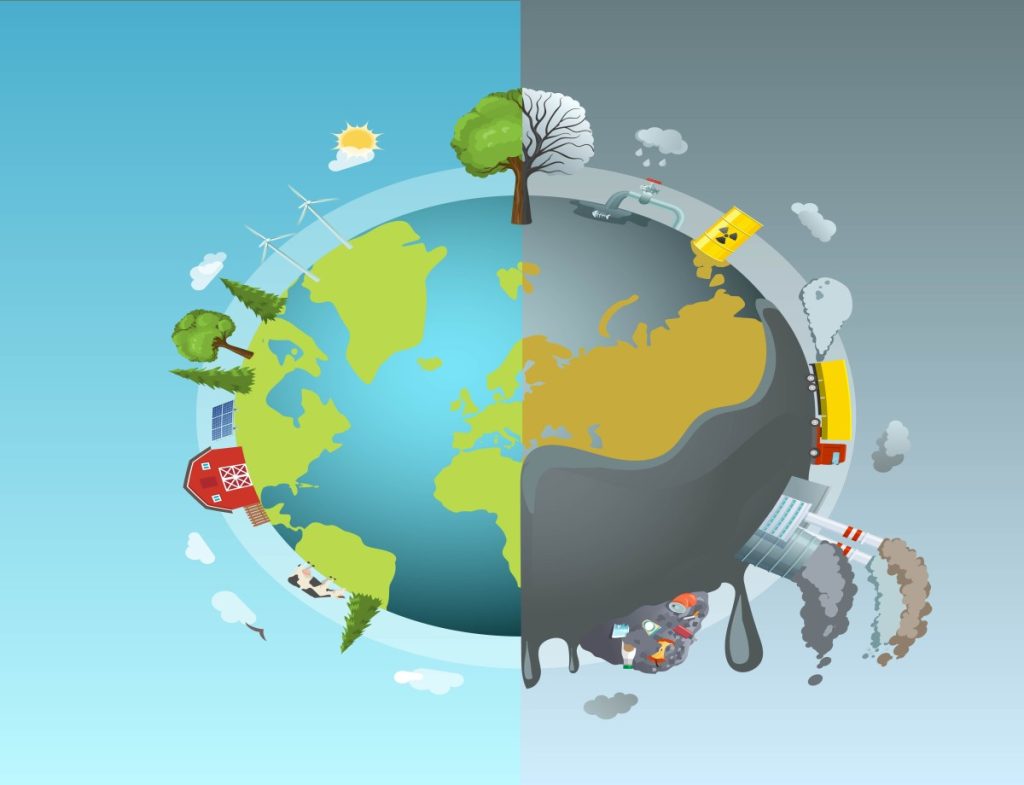Abstract Global warming, a significant rise in Earth’s average surface temperature, is one of the most pressing environmental challenges of the 21st century. Driven predominantly by human activities, particularly the burning of fossil fuels, deforestation, and industrial processes, global warming threatens ecosystems, economies, and human societies. This research article delves into the science behind global warming, its causes and impacts on natural and human systems, and the possible solutions to mitigate its effects.
Table of Contents
Toggle1. Introduction of Global Warming
Global warming refers to the long-term increase in Earth’s average temperature, particularly since the late 19th century, and is largely attributed to human activities. The main contributor to global warming is the enhanced greenhouse effect, which results from the accumulation of greenhouse gases (GHGs) such as carbon dioxide (CO₂), methane (CH₄), and nitrous oxide (N₂O) in the atmosphere. This article examines the science, causes, consequences, and potential solutions to address global warming.
2. Causes of Global Warming
2.1. The Greenhouse Effect
The greenhouse effect is a natural process that warms the Earth’s surface. When the Sun’s energy reaches the Earth, some of it is reflected in space, while the rest is absorbed, warming the planet. The absorbed energy is re-radiated as heat (infrared radiation). Greenhouse gases (GHGs) in the atmosphere trap some of this heat, preventing it from escaping into space, and thus maintaining Earth’s temperature at a level conducive to life.
However, human activities have intensified this natural process by increasing the concentration of GHGs, leading to more heat being trapped, which raises global temperatures.
2.2. Human Contributions to GHG Emissions
- Burning of Fossil Fuels: The combustion of coal, oil, and natural gas for energy production is the largest source of GHG emissions. This includes electricity generation, transportation, and industrial processes, releasing vast amounts of CO₂ into the atmosphere.
- Deforestation: Trees act as carbon sinks, absorbing CO₂. Deforestation, particularly in tropical rainforests, releases stored carbon back into the atmosphere and reduces the planet’s ability to absorb CO₂.
- Agriculture and Livestock: Agricultural practices, including rice cultivation and livestock farming, release methane (CH₄), a potent GHG. Methane is released through livestock digestion and manure management, while nitrous oxide (N₂O) comes from fertilizers used in agriculture.
- Industrial Activities: Certain industrial processes, such as cement production and chemical manufacturing, emit large quantities of CO₂ and other GHGs.
- Waste Management: The decomposition of organic waste in landfills produces methane, further contributing to global warming.
3. Impacts of Global Warming
3.1. Environmental Impacts
- Rising Temperatures: Global temperatures have increased by approximately 1.2°C since the pre-industrial era (1850-1900). This rise leads to more frequent and intense heatwaves, droughts, and shifts in weather patterns.
- Melting Polar Ice and Glaciers: Warming temperatures are causing polar ice caps and glaciers to melt at an alarming rate. This contributes to rising sea levels, which threaten coastal communities and ecosystems. Arctic sea ice is shrinking, endangering species like polar bears and altering oceanic circulation patterns.
- Rising Sea Levels: The melting of glaciers and polar ice, combined with the thermal expansion of seawater, leads to rising sea levels. It is estimated that sea levels could rise by up to 1 meter by the end of the century, threatening low-lying islands and coastal cities like Miami, New York, and Mumbai.
- Ocean Acidification: Oceans absorb a significant portion of atmospheric CO₂, leading to increased acidity. This acidification harms marine life, particularly organisms with calcium carbonate shells, such as corals, mollusks, and some plankton species, disrupting marine food webs.
- Loss of Biodiversity: Climate change leads to habitat loss, species migration, and extinction. Coral reefs, which support a large proportion of marine biodiversity, are at high risk due to ocean warming and acidification. Similarly, terrestrial species are facing shrinking habitats as ecosystems shift and degrade.
3.2. Socioeconomic Impacts
- Agriculture and Food Security: Changing climate patterns disrupt growing seasons, leading to crop failures and reduced agricultural productivity. This threatens food security, particularly in regions that are already vulnerable to hunger and poverty.
- Water Scarcity: Global warming exacerbates water scarcity, particularly in arid and semi-arid regions. Melting glaciers, decreased rainfall, and changing precipitation patterns reduce freshwater availability, intensifying competition for water resources.
- Human Health: Rising temperatures increase the incidence of heat-related illnesses and deaths. Warmer climates also extend the range of disease vectors like mosquitoes, increasing the spread of diseases such as malaria, dengue, and Zika virus. Air pollution, worsened by climate change, exacerbates respiratory conditions like asthma.
- Displacement and Migration: Rising sea levels and extreme weather events lead to the displacement of millions of people. Climate refugees are increasingly becoming a reality, as people are forced to leave their homes due to flooding, droughts, and other climate-induced disasters.
- Economic Losses: The costs of global warming are vast and include damage to infrastructure, loss of agricultural productivity, healthcare expenses due to climate-related diseases, and the expense of mitigating and adapting to the changing climate. The economic burden disproportionately affects poorer countries that have contributed the least to global GHG emissions.
4. Mitigation and Adaptation Strategies
4.1. Mitigation Efforts
- Transition to Renewable Energy: Reducing reliance on fossil fuels is crucial to mitigating global warming. Renewable energy sources like solar, wind, hydro, and geothermal offer clean alternatives to carbon-intensive energy production.
- Energy Efficiency: Improving energy efficiency in industries, transportation, and buildings can significantly reduce GHG emissions. This includes innovations such as energy-efficient appliances, electric vehicles, and green building designs.
- Reforestation and Afforestation: Planting trees and restoring forests enhance carbon sequestration, helping to absorb excess atmospheric CO₂. Protecting existing forests is also critical to maintaining these natural carbon sinks.
- Carbon Capture and Storage (CCS): CCS technologies capture CO₂ emissions from power plants and industrial facilities and store them underground or in other secure locations, preventing them from entering the atmosphere.
- Shifting to Sustainable Agriculture: Reducing methane emissions from livestock, optimizing fertilizer use, and adopting sustainable farming practices can lower agriculture’s contribution to global warming.
4.2. Adaptation Measures
- Building Climate-Resilient Infrastructure: Adapting infrastructure to withstand extreme weather events, sea-level rise, and other climate impacts can reduce vulnerability. This includes constructing flood defenses, strengthening buildings, and improving drainage systems.
- Water Management: Developing efficient water management systems, such as rainwater harvesting and desalination, can help alleviate water scarcity in drought-prone regions.
- Climate-Smart Agriculture: Developing crops that are resistant to climate stressors such as drought and heat can improve food security. Diversifying agricultural systems and implementing sustainable practices also reduce vulnerability to climate change.
- Early Warning Systems: Investing in early warning systems for extreme weather events can save lives and reduce damage. This includes better forecasting hurricanes, floods, and heatwaves, allowing for timely evacuations and disaster preparedness.
- Social Safety Nets: Strengthening social safety nets, such as disaster relief funds and climate insurance programs, can protect vulnerable communities from the economic shocks of climate-related disasters.
5. Global Policy Responses
- The Paris Agreement (2015): The Paris Agreement is a landmark international accord where nearly all countries committed to limiting global temperature rise to well below 2°C, with efforts to cap the increase at 1.5°C. It emphasizes reducing GHG emissions, promoting climate resilience, and financing climate adaptation efforts, especially in developing nations.
- National Commitments (NDCs): As part of the Paris Agreement, countries submitted Nationally Determined Contributions (NDCs) outlining their climate goals. These commitments must be updated every five years to reflect increased ambition over time.
- Carbon Pricing and Emission Trading: Many countries have adopted carbon pricing mechanisms, such as carbon taxes and cap-and-trade systems, to incentivize emissions reductions by placing a cost on carbon pollution.
6. Conclusion
Global warming is an urgent and complex issue that requires coordinated global action. While human activities have significantly contributed to the rise in global temperatures, it is within our capacity to mitigate the impacts of global warming through sustainable energy transitions, reforestation, policy reforms, and adaptation strategies. International cooperation, technological innovation, and societal commitment are crucial to addressing this existential threat.
References
- Intergovernmental Panel on Climate Change (IPCC). (2021). Sixth Assessment Report.
- National Aeronautics and Space Administration (NASA). (2023). Global Climate Change: Vital Signs of the Planet.
- United Nations Environment Programme (UNEP). (2022). Emissions Gap Report 2022.
- World Health Organization (WHO). (2021). Climate Change and Health Fact Sheet.
This article provides a comprehensive overview of global warming’s causes, effects, and responses, emphasizing the urgent need for action to mitigate and adapt to its impacts.







